Tuesday, April 28. 2009
By Joe Fletcher on April 27th, 2009
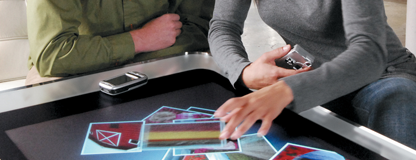
Over the last few years, social computing has been relegated to asynchronous websites like FaceBook and Twitter, where users connect with many people and their collective information is harvested for the larger group. However these are still largely individually actions, not synchronous… yet we call it “social”. I would like to expand that definition.
Think of a computer where you sit down and work simultaneously with your friend. Imagine you and your friends all playing a game or solving a problem at the same time on the same computer. This has been one of the key aspects of our vision at Microsoft Surface. As I’ve presented over the last year on Surface, I’ve talked a lot about the aspects of social computing. Initially when I started on the team I was skeptical of social computing as Surface defines it: multiple people working around a single computer. Since that time, I have seen some of the great innovations and situations that Surface style social computing allows. With its vision system (instead of capacitive or infra-red), Surface can recognize 52 simultaneous points of touch, as well as physical objects, making it a computer for a truly social environment.
Social computing is described as the intersection between social behavior and computing systems, and often in somewhat ambiguous computational terms. I question how much of what happens on social sites like FaceBook [et al] is really social (I don’t often come to work sharing a list of 25 personal oddities about myself). The only real social aspect is that you’re sharing items with other people in an easy way across geographic divides. Although the web seems like a macrocosm of that definition. I’m not sure why things like instant messaging are not considered social computing, but they are more social than most sites bearing that label.
I would like to implore readers to expand their definition of the term social computing and realize it can apply to many more situations than it currently is; those being actual social situations. I would describe that as what Surface is aspiring to be, the first true social computer. It provides context and use for multiple people, on all sides. Although true social computing can be done with a single computer and two or more people, it may not be optimal. Below are a few of the ways I’ve come to think about social computer usage:
- Driver as a presenter: this happens when you’re showing someone a YouTube video
- Driver (w/ an influencer or back seat driver): this happens when you’re searching the internet for someone and someone is telling you what do type in
- Turn taking: passing a laptop back and forth to share information
- Simultaneous: both playing a game on Microsoft Surface. I’ll call this synchronous social activities. Very different from the three above it
Of course none of what I describe here is the current way we define social computing, which is why I’m asking people to expand their thinking. Perhaps there is another word to describe these situations? Whatever happens, it’s become clear to me that the computer cannot simply stay as the personal device it has been and designers should begin to think about social proximity activities and behaviors. As technology becomes more pervasive and cultures become more acquiesced to computers, there will be a need and desire to continue and expand the social aspects.
As an aside, while I bring up Surface several times in my posts, please don’t take that for blindly selling the technology. I am very aware of its flaws and issues, and part of my opportunity at Microsoft is to make those better. For those interested, here is my talk from MIX09 on Surface and touch computing where I discuss both my love and discomforts on those topics.
-----
Via Johnny Holland Magazine
Personal comment:
Je trouve intéressant, à un moment ou tout le monde fonce dans le tas du buzz "social computing", de questionner ce terme. Ici, le point intéressant est qu'on signale le caractère asynchrone de Facebook et Twitter (bien que Facebook prétende vouloir aller vers le temps réel avec le flux de chaque "Wall" --mais je ne serai pas étonné d'apprendre qu'ils sont en réalité revenu en arrière car cela s'avère assez indigeste et s'approche du spam--). Il y a quelques années, tout le monde ne jurait que par le "synchrone" et les "réseaux sociaux" étaient plutôt appelés des "multi-users" (chat, réalité virtuelle partagée, IM, jeux partagés, etc.). Il fallait du "temps réel", de l'interaction entre personnes et en direct.
Une fois la folie des réseaux sociaux passées, je ne serai pas étonné de voir resurgir le "temps réel" et peut-être que l'avenir des réseaux sociaux sera alors dans une hybridation synchrone-asynchrone, avec capacité de parfaitement "tuner" cette question des flux et du rapport au "temps réel" ou au "temps différé".
Friday, April 24. 2009

M-novels (standing for Mobile-novels), M-soap (Mobile-soap, etc.) operas and a musician who goes on world tour from his living room - Kirsty Allison reports from Tokyo in this special CR film on Japan’s mobile culture
More on what Kirsty saw:

M-FILM: the Pocket Films Festival
“These screens are portable, digital and easy to edit and distribute from. It’s culture in your pocket,” says Professor Masaki Fujihata of the Tokyo University of Arts, and director of the Tokyo Pocket Films Festival. He sees the medium as the message, with M-films currently serving as sketchpads for ideas where an ideal duration is under five minutes, although he predicts that future M-films “will go on to win Oscars”.
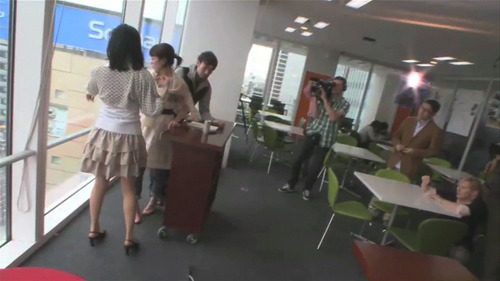
M-SOAP OPERAS: Voltage
Production company Voltage specialises in M-games and M-soap operas. Shooting for half an hour a week, Voltage breaks weekly stories down to five-minute chunks which get downloaded by young girls largely in search of romantic titillation. It claims hits of up to 10K per episode. CEO Tsuya Yuuzi likens the current era to the early gaming industry.
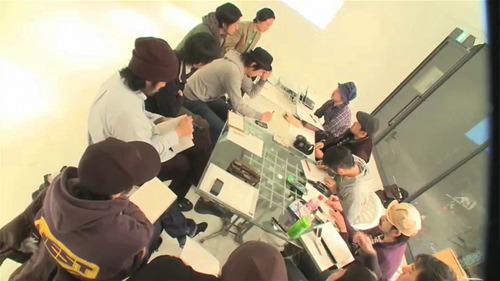
M-STREET ART: HP France Gallery
Shibuya’s hub of hip is this basement gallery where street artists such as Sense, Baku, Kanosue Shunsuke and Takeru Nakabayashi meet with software developers to design comedy mobile interfaces that add a little more wasabi heat to regular mobile menus. These collaborations lead to animations such as sushi belts which speed up and slow down according to levels of mobile reception. Mao Sakaguchi, curator of HP France began customising screensavers with artists several years ago, 3 is the first British company to adopt similar tactics to reach the social networking, data-loving generation, and has recently commissioned artists to create screensavers for its INQ handset.

M-LIVE: Merce Death
The name for this one man band derives from the Japanese pronunciation of Mercedes. Art director and home lover, Shingo Oono goes on world tour from his living room studio in the suburbs of Tokyo, thanks to the wonders of modern technology (mainly streaming site, Ustream.com); he layers guitars with bass and drums, broadcasting direct from home. Watch online, on phone, or join in with the World Online Jam.
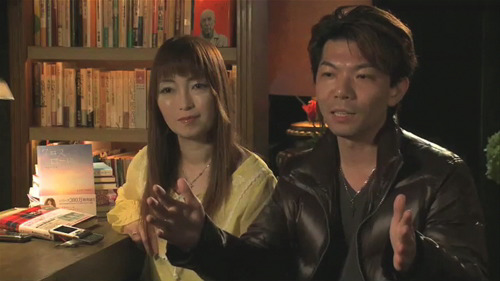
M-BOOKS: M-Novelists
The Keitai Shousetsu phenomenon is particularly popular with the young, and is encouraging them to get back into books. Written and delivered on mobiles (authors Honjo Sae and Tadashi Izumi, above), with associated paperbacks, merchandise, anime and TV, this is true cross-platform culture. M-books follow viral patterns, with initial chapters often being free. Bestselling Tokyo Real has 32m hits, and paperback sales of 3m plus.
Kirsty Allison travelled to Tokyo as part of the 3snapshots.com project
-----
Via Creative Review
Personal comment:
On sait depuis longtemps que le Japon est presque passé tout de suite (peu après l'avènement d'Internet) dans une culture des contenus mobiles, sans vraiment passer par un stade "wired/desktop" du fait qu'ils possédaient la technologie et le réseau cellulaire (Docomo) adéquat et que les gens était surtout équipés de cette façon. Ils ont donc développés prioritairement cette culture, contrairement à l'Europe ou les Etats-Unis qui possèdent une double culture du desktop et de la mobilité, avec une approche de complémentarité. La portion "mobile" étant actuellement en train de se développer, sans toutefois s'imposer clairement (téléchargements, applications, jeux, gps, podcasts et vodcasts plutôt que web).
Il est intéressant toutefois d'effectuer une "veille nipponne" relative aux usages, comportements sociaux et développements des contenus mobiles du fait de leur "avance" dans le domaine (mais tenant compte aussi de leur différence techno-culturelle). Ici l'émergence de ce terme "Mohemians".
Wednesday, April 22. 2009
 Google has introduced a new feature to give you a bit more control over what comes up when someone searches for your name – sort of. Google has introduced a new feature to give you a bit more control over what comes up when someone searches for your name – sort of.
Now, when you search for a name on Google, you’ll get a list of the Google Profiles that users have setup under that name at the bottom of search results. If you haven’t yet setup a Google Profile, you’ll now be provided with the option to do so when you Google “me”.
This is going to be a welcome addition for lots of people, especially those who aren’t necessarily happy with what links Google has for them on the first page of results. It also solves the problem of sharing a name with someone that happens to be a popular search term. For Google though, it could be a big boon to Google Profiles, the service that is powering this whole thing.
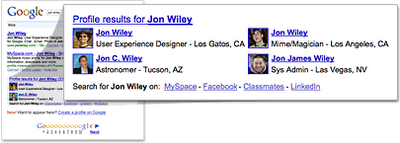
Google Profiles themselves are rather basic, allowing you to enter some details about yourself, link to your social networking profiles, upload a photo, and share contact details with specific groups of people that you setup. They’re also available at a custom URL – google.com/profiles/yourname. If you want your profile to show up in search results, you’ll need to opt-in via the Google Profiles site - it’s not automatically included.
Now that they are integrated in Google ego searches, you can imagine that people are going to be paying a lot more attention to what’s in their Google Profile and keeping it updated with more frequency. As such, Google might have just unlocked an incredibly important piece of their social networking strategy. There might not be a social network (in the traditional sense) built around Google Profiles just yet, but the groundwork has just been laid in a very big way.
-----
Via Mashable
Personal comment:
Oui, bien sûr, nous avons tous fait des recherches pour le nom de telle ou telle personne, pour son propre nom, etc.
Google offre maintenant une possibilité de customiser partiellement les résultats des recherches qui concernent sa propre identité/personne --US only! pour l'instant-- (et collecte au passage quelques informations utiles puisqu'il faut posséder un compte Google...)
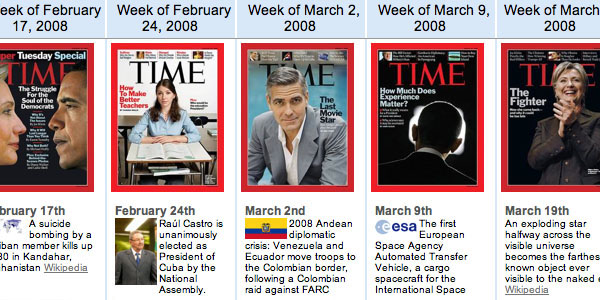
News Timeline [googlelabs.com] is a new Google Labs feature, which organizes news stories and other information by date. It allows users to view news and other data sources on a browsable, graphical timeline. The Google engineer who built it, Andy Hertzfeld, says he was inspired by Google Maps, but instead of letting people navigate through space, he wanted to let them navigate through time.
The depth and richness of the available datasets is impressive: news, magazines, blogs, TV shows, music, video games,... But also buildings, prizes, and artworks. For instance, blog posts can be shown on the timeline by selecting "Blogs" from the data source menu and typing the name of the blog in the query field.
As this news will distract you from your work anyway, you can also check out the recent Google Labs Similar Images page, which lets you refine image searches by visual similarity.
Via TechCrunch.
-----
Via Information aesthetics
Personal comment:
Browser les contenus à travers le temps (après y accèder à trvers l'espace --Google Maps--): l'empire de Google s'étend aux différentes dimensions...
Friday, April 17. 2009
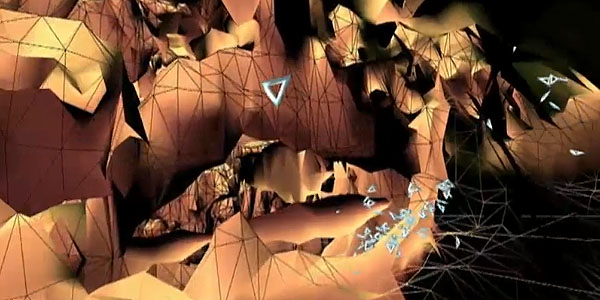
Composer JoAnn Kuchera-Morin, director of the Center for Research in Electronic Art Technology (CREATE) at UC Santa Barbara, demos the AlloSphere [ucsb.edu] at a TED talk, and show an entirely new way to see and interpret scientific data, in full color and surround sound inside a 3-story high, massive metal sphere.
Some of the claims seem a bit far-fetched, but the presentation is amazing and compelling nonetheless. The presentation lets you dive into the brain, feel electron spin, hear the music of the elements. Works shown include an interactive visualization of unique atomic bonds, an immersive art installation bringing forth a complex ecosystem of creativity and a multimodal representation of quantum mechanics.
Watch the video HERE.
-----
Via Information aethetics
Personal comment:
L'architecte Marcos Novak, rencontré lors de Postopolis!LA, m'a parlé de cette sphère de visualisation (et proposé d'y réaliser un travail). Il est lui-même enseignant en architecture à UCSB et a utilisé l'Allosphere à différente reprise.
|







 Google has
Google has 


